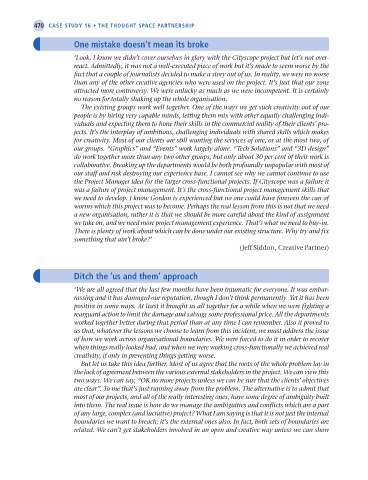Page 495 - Operations Strategy
P. 495
470 case study 16 • the thought space partnership
one mistake doesn’t mean its broke
‘Look, I know we didn’t cover ourselves in glory with the Cityscope project but let’s not over-
react. Admittedly, it was not a well-executed piece of work but it’s made to seem worse by the
fact that a couple of journalists decided to make a story out of us. In reality, we were no worse
than any of the other creative agencies who were used on the project. It’s just that our zone
attracted more controversy. We were unlucky as much as we were incompetent. It is certainly
no reason for totally shaking up the whole organisation.
The existing groups work well together. One of the ways we get such creativity out of our
people is by hiring very capable minds, letting them mix with other equally challenging indi-
viduals and expecting them to hone their skills in the commercial reality of their clients’ pro-
jects. It’s the interplay of ambitious, challenging individuals with shared skills which makes
for creativity. Most of our clients are still wanting the services of one, or at the most two, of
our groups. “Graphics” and “Events” work largely alone. “Tech Solutions” and “3D design”
do work together more than any two other groups, but only about 30 per cent of their work is
collaborative. Breaking up the departments would be both profoundly unpopular with most of
our staff and risk destroying our experience base. I cannot see why we cannot continue to use
the Project Manager idea for the larger cross-functional projects. If Cityscope was a failure it
was a failure of project management. It’s the cross-functional project management skills that
we need to develop. I know Gordon is experienced but no one could have foreseen the can of
worms which this project was to become. Perhaps the real lesson from this is not that we need
a new organisation, rather it is that we should be more careful about the kind of assignment
we take on, and we need more project management experience. That’s what we need to buy-in.
There is plenty of work about which can be done under our existing structure. Why try and fix
something that ain’t broke?’
(Jeff Siddon, Creative Partner)
ditch the ‘us and them’ approach
‘We are all agreed that the last few months have been traumatic for everyone. It was embar-
rassing and it has damaged our reputation, though I don’t think permanently. Yet it has been
positive in some ways. At least it brought us all together for a while when we were fighting a
rearguard action to limit the damage and salvage some professional price. All the departments
worked together better during that period than at any time I can remember. Also it proved to
us that, whatever the lessons we choose to learn from this incident, we must address the issue
of how we work across organisational boundaries. We were forced to do it in order to recover
when things really looked bad, and when we were working cross-functionally we achieved real
creativity, if only in preventing things getting worse.
But let us take this idea further. Most of us agree that the roots of the whole problem lay in
the lack of agreement between the various external stakeholders in the project. We can view this
two ways. We can say, “OK no more projects unless we can be sure that the clients’ objectives
are clear”. To me that’s just running away from the problem. The alternative is to admit that
most of our projects, and all of the really interesting ones, have some degree of ambiguity built
into them. The real issue is how do we manage the ambiguities and conflicts which are a part
of any large, complex (and lucrative) project? What I am saying is that it is not just the internal
boundaries we want to breach; it’s the external ones also. In fact, both sets of boundaries are
related. We can’t get stakeholders involved in an open and creative way unless we can show
Z16 Operations Strategy 62492.indd 470 02/03/2017 14:00

